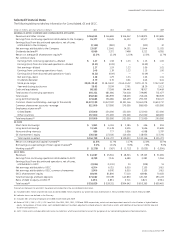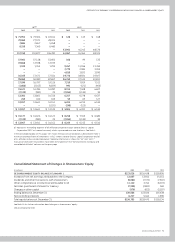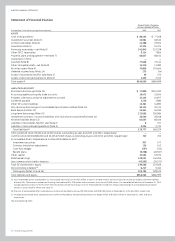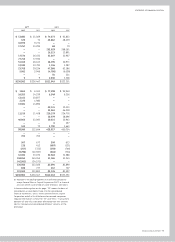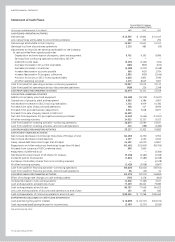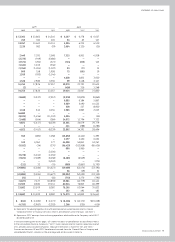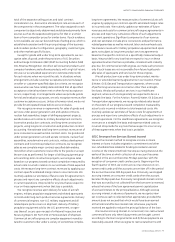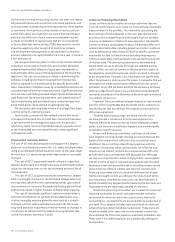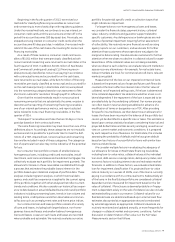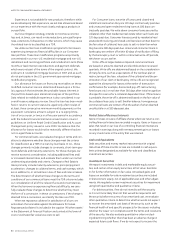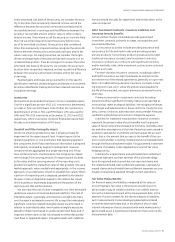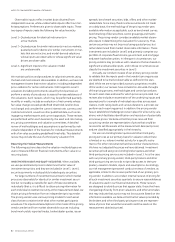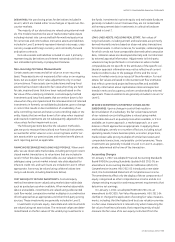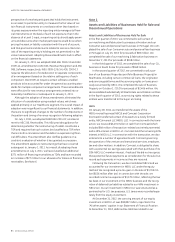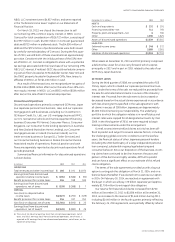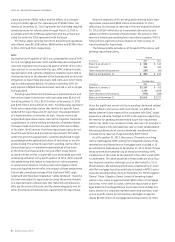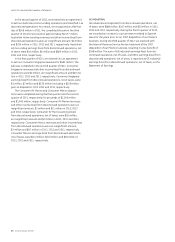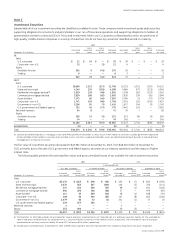GE 2013 Annual Report Download - page 81
Download and view the complete annual report
Please find page 81 of the 2013 GE annual report below. You can navigate through the pages in the report by either clicking on the pages listed below, or by using the keyword search tool below to find specific information within the annual report. GE 2013 ANNUAL REPORT 79
Beginning in the fourth quarter of 2013, we revised our
methods for classifying fi nancing receivables as nonaccrual
and nonearning to more closely align with regulatory guidance.
Under the revised methods, we continue to accrue interest on
consumer credit cards until the accounts are written off in the
period the account becomes 180 days past due. Previously, we
stopped accruing interest on consumer credit cards when the
account became 90 days past due. In addition, the revised meth-
ods limit the use of the cash basis of accounting for nonaccrual
fi nancing receivables.
As a result of these revisions, consumer credit card receiv-
ables of $1,051 million that were previously classifi ed as both
nonaccrual and nonearning were returned to accrual status in the
fourth quarter of 2013. In addition, $1,524 million of Real Estate
and Commercial Lending and Leasing (CLL) fi nancing receiv-
ables previously classifi ed as nonaccrual, paying in accordance
with contractual terms and accounted for on the cash basis,
were returned to accrual status, while $2,174 million of fi nancing
receivables previously classifi ed as nonaccrual and accounted for
on the cash basis (primarily in Real Estate and CLL) were placed
into the nonearning category based on our assessment of the
short-term outlook for resolution through payoff or refi nance.
Given that the revised methods result in nonaccrual and
nonearning amounts that are substantially the same, we plan to
discontinue the reporting of nonearning fi nancing receivables,
one of our internal performance metrics, and report selected
ratios related to nonaccrual fi nancing receivables, in the fi rst
quarter of 2014.
“Delinquent” receivables are those that are 30 days or more
past due based on their contractual terms.
The same fi nancing receivable may meet more than one of the
defi nitions above. Accordingly, these categories are not mutually
exclusive and it is possible for a particular loan to meet the defi -
nitions of a TDR, impaired loan, nonaccrual loan and nonearning
loan and be included in each of these categories. The categoriza-
tion of a particular loan also may not be indicative of the potential
for loss.
Our consumer loan portfolio consists of smaller-balance,
homogeneous loans, including credit card receivables, install-
ment loans, auto loans and leases and residential mortgages. We
collectively evaluate each portfolio for impairment quarterly. The
allowance for losses on these receivables is established through
a process that estimates the probable losses inherent in the
portfolio based upon statistical analyses of portfolio data. These
analyses include migration analysis, in which historical delin-
quency and credit loss experience is applied to the current aging
of the portfolio, together with other analyses that refl ect current
trends and conditions. We also consider our historical loss experi-
ence to date based on actual defaulted loans and overall portfolio
indicators including nonearning loans, trends in loan volume and
lending terms, credit policies and other observable environmen-
tal factors such as unemployment rates and home price indices.
Our commercial loan and lease portfolio consists of a variety
of loans and leases, including both larger-balance, non-homo-
geneous loans and leases and smaller-balance homogeneous
loans and leases. Losses on such loans and leases are recorded
when probable and estimable. We routinely evaluate our entire
portfolio for potential specifi c credit or collection issues that
might indicate an impairment.
For larger-balance, non-homogeneous loans and leases,
we consider the fi nancial status, payment history, collateral
value, industry conditions and guarantor support related to
specifi c customers. Any delinquencies or bankruptcies are indi-
cations of potential impairment requiring further assessment
of collectibility. We routinely receive fi nancial as well as rating
agency reports on our customers, and we elevate for further
attention those customers whose operations we judge to be
marginal or deteriorating. We also elevate customers for further
attention when we observe a decline in collateral values for asset-
based loans. While collateral values are not always available,
when we observe such a decline, we evaluate relevant markets to
assess recovery alternatives—for example, for real estate loans,
relevant markets are local; for commercial aircraft loans, relevant
markets are global.
Measurement of the loss on our impaired commercial loans
is based on the present value of expected future cash fl ows dis-
counted at the loan’s effective interest rate or the fair value of
collateral, net of expected selling costs, if the loan is determined
to be collateral dependent. We determine whether a loan is col-
lateral dependent if the repayment of the loan is expected to be
provided solely by the underlying collateral. Our review process
can often result in reserves being established in advance of a
modifi cation of terms or designation as a TDR. After providing
for specifi c incurred losses, we then determine an allowance for
losses that have been incurred in the balance of the portfolio but
cannot yet be identifi ed to a specifi c loan or lease. This estimate is
based upon various statistical analyses considering historical and
projected default rates and loss severity and aging, as well as our
view on current market and economic conditions. It is prepared
by each respective line of business. For Real Estate, this includes
assessing the probability of default and the loss given default
based on loss history of our portfolio for loans with similar loan
metrics and attributes.
We consider multiple factors in evaluating the adequacy of
our allowance for losses on Real Estate fi nancing receivables,
including loan-to-value ratios, collateral values at the individual
loan level, debt service coverage ratios, delinquency status, and
economic factors including interest rate and real estate market
forecasts. In addition to these factors, we evaluate a Real Estate
loan for impairment classifi cation if its projected loan-to-value
ratio at maturity is in excess of 100%, even if the loan is currently
paying in accordance with its contractual terms. Substantially all
of the loans in the Real Estate portfolio are considered collateral
dependent and are measured for impairment based on the fair
value of collateral. If foreclosure is deemed probable or if repay-
ment is dependent solely on the sale of collateral, we also include
estimated selling costs in our reserve. Collateral values for our
Real Estate loans are determined based upon internal cash fl ow
estimates discounted at an appropriate rate and corroborated
by external appraisals, as appropriate. Collateral valuations are
routinely monitored and updated annually, or more frequently for
changes in collateral, market and economic conditions. Further
discussion on determination of fair value is in the Fair Value
Measurements section that follows.


